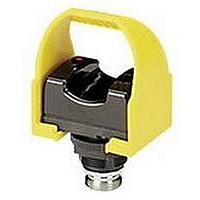OTBVR81L BANNER ENGINEERING, OTBVR81L Datasheet - Page 4

OTBVR81L
Manufacturer Part Number
OTBVR81L
Description
PHOLOELECTRIC SENSOR
Manufacturer
BANNER ENGINEERING
Datasheet
1.OTBA5.pdf
(6 pages)
Specifications of OTBVR81L
Output Current
7A
Sensor Output
Relay
Leaded Process Compatible
No
Peak Reflow Compatible (260 C)
No
4
Use of OPTO-TOUCH Optical Touch Buttons for Two-hand Machine Trip Controls
Requirements for Anti-tiedown Circuitry
Two-hand trip control has been a popular means for actuation of single-stroke presses
and other single-cycle machinery for many years. Optical touch buttons (OTBs)
provide an ergonomic (stress-free) alternative to conventional mechanical push buttons
used as actuators in two-hand trip controls.
OSHA Requirement for Anti-tiedown Control
Use of OTBs for two-hand trip machine actuation must include "anti-tiedown"
control to prevent any means of defeating one or both actuators to create a one-hand
trip. Federal law mandates the use of anti-tiedown control when two-hand trip actuators
are used for cycle initiation of a single stroke part revolution clutched mechanical power
press. OSHA Code of Federal Regulation, 7-1-92 Edition, CFR Title 29, Part 1910.217
(b) (6) (i) states:
Concurrent or "synchronous" actuation of two-hand trips is the most popular approach to anti-tiedown control. European
Standard prEN 574, titled "Safety of Machinery - Two-handed Control Device", defines synchronous actuation as follows:
NOTE: In addition to the standards and regulations mentioned above, there are numerous regulations and machine safety
standards that apply to specific industries. For assistance in obtaining copies of any of these standards, contact Banner
at the address or numbers listed at the bottom of page 6
When properly installed, a two-hand control device using OPTO-TOUCH OTB Series Optical Touch Buttons can provide
protection only for the hands of the machine operator, and is not a point of operation personnel guarding device, as defined
by OSHA regulations. It is necessary to install point of operation guarding devices, such as safety light curtains and/or hard
guards, to protect personnel from dangerous machine motion.
!
"A two-hand trip shall have the individual operator’s hand controls protected against unintentional
operation and have the individual operator’s hand controls arranged by design and construction
and/or separation to require the use of both hands to trip the press and use a control arrangement
requiring concurrent operation of the individual operator’s hand controls."
"6.7 Synchronous actuations
In synchronous actuation an output signal shall be generated only when both control actuating
devices are actuated - in a time which is less than or equal to 0.5 seconds...
... If the control actuating devices are not actuated synchronously the output signal shall be
prevented and it shall be necessary to release both control actuating devices and to reinitiate
both input signals."
!
WARNING!
Never use an OPTO-TOUCH Optical Touch Button as an actuator in an emergency stop (E-Stop)
circuit. E-Stop actuators must be purely mechanical devices that require no power to operate. OPTO-
TOUCH Optical Touch Buttons require power to operate and must not be used as E-Stop actuators under
any circumstances.
WARNING !
In the United States, the functions that a two-hand control device is intended to perform are regulated by the
Occupational Safety and Health Administration (OSHA). Whether or not any particular two-hand control
system installation meets all applicable OSHA requirements depends upon the details of how the two-hand
control device is applied, installed, operated, and maintained.
Important Application Information
.









